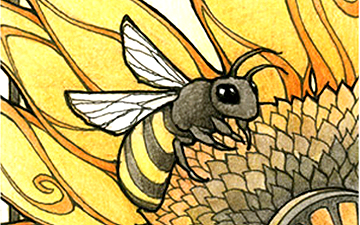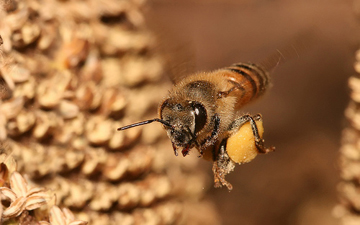The European honey bee or western honey bee (Apis mellifera) is a species of honey bee. The genus Apis is Latin for “bee”, and mellifera comes from Greek melli- “honey” and ferre “to bear” — hence the scientific name means “honey-bearing bee”. The name was coined in 1758 by Carolus Linnaeus who, realizing that the bees do not bear honey, but nectar, tried later to correct it to Apis mellifica (“honey-making bee”) in a subsequent publication. However, according to the rules of synonymy in zoological nomenclature, the older name has precedence. As of October 28, 2006, the Honey Bee Genome Sequencing Consortium fully sequenced and analyzed the genome of Apis mellifera.
In 2007 media attention focused on Colony Collapse Disorder, a decline in European honey bee colonies in a minority of regions of North America.
(From Wikipedia, April 23, 2010)
– – –
Generally, Apis mellifera are red/brown with black bands and orange yellow rings on abdomen. They have hair on thorax and less hair on abdomen. They also have a pollen basket on their hind legs. Honeybee legs are mostly dark brown/black.
There are two castes of females, sterile workers are smaller (adults 10-15 mm long), fertile queens are larger (18-20 mm). Males, called drones, are 15-17 mm long at maturity. Though smaller, workers have longer wings than drones. Both castes of females have a stinger that is formed from modified ovipositor structures. In workers, the sting is barbed, and tears away from the body when used. In both castes, the stinger is supplied with venom from glands in the abdomen. Males have much larger eyes than females, probably to help locate flying queens during mating flights.
(From EOL via Animal Diversity Web, April 23, 2010)





